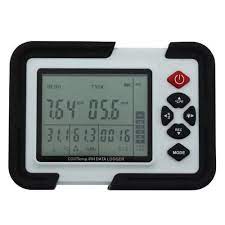A data logger that is specialized or designed for temperature sensors or sensors. In the case of a humidity and temperature data logger, humidity sensors as well is known as data logger.
A temperature data logger is a piece of technology that may record various readings. It typically runs on batteries and takes one or even more sensor inputs before sampling and storing the data at regular intervals.
The logger is retrieved and the data is transferred onto a PC for examination after the acquisition period. There is no longer a need for field trips thanks to some data loggers, which even send the measurement findings to a PC or another device.
Types of Temperature data logger:
The temperature sensor or detectors and the recording mechanism take the sensor at regular intervals. Records of the measurement result are the two fundamental components of every data logger. This sensor can be positioned close to the monitoring system or integrated directly into it. They are of four types:
With external probe attached:
The temperature sensor or detectors and the recording mechanism that takes the sensor at regular intervals and records the measurement result are the two fundamental components of every data logger. This sensor can be positioned close to the monitoring system or integrated directly into it.
With Internal Sensor:
A logger may be made small and light by directly combining a thermistor or thermocouple with it in one package. Its drawback is that it has to be situated where the temperature will be monitored.
Because the electrical components in the device must operate inside a working temperature range, this prohibits internal sensor loggers from being utilized in high-temperature situations. Furthermore, it makes them handy for recording in-transit temperatures, which may be necessary when transporting artwork or perishable goods like eggs.
With thermocouple input:
One or more thermocouples can be directly plugged into many temperature recorders. This allows for the close-by thermocouple data logger temperature to be recorded. Therefore it is not an appropriate method when the temperature is too high or low for the batteries and electronics.
Many of them are portable recorders meant for recording for just brief periods. Some general-purpose data loggers are equipped with inputs for thermocouples and thermistors, making it simple to utilize them as thermometers.
How is data retrieved from the Data Logger?
Many data loggers that have embedded sensors are made to look like USB drives and may be plugged into a computer’s USB port to download data. Others use the USB interface but call for a different cable.
Another choice is to connect the logger to a computer or maybe even a mobile device through a Bluetooth® interface. While some loggers utilize WiFi to transmit measurements, others may be used an Ethernet cable to transmit information back to a central PC. Both methods do away with the need to go out to a recorder. In the field to retrieve the data from the data logger.
Application of Temperature data logging:
High-Temperature Logging:
A recording device designed for temperatures above 80°C is typically referred to as a high-temperature logger, but there is no strict definition of high temperature. Pasteurization, food processing, and autoclaves are examples of high-temperature settings.
One illustration is food canning. In this case, producers must provide proof that the product has achieved the bare minimum temperature required to kill bacteria like botulism. Loggers designed for these temperatures frequently include a probe to keep the delicate electronics cool.
Cold Chain:
To prevent spoiling, many foods and even medicines must be delivered in tightly regulated environments. Putting a small temperature data recorder in with the items being carried so that it can keep track of the environmental conditions. This helps to maintain the items’ integrity and provides proof if any claims of improper treatment are made.
Water Temperature Logging:
The purpose of water temperature monitoring in aquariums is to maintain a healthy habitat for the fish, most of which can solely survive inside a specific range. In a similar line, researchers utilize river and stream temperatures as a gauge of the health of such ecosystems. Both are excellent uses for a water Temperature data logger, but they have different requirements for the tool.
Humidity Logging:
A history of temperature and humidity change can be helpful in facility management, particularly if precise measurement or temperature-sensitive operations are done, to spot inefficiencies. In the propagation of both plants and animals, the same is true. The temperature and humidity data recorders together give a moment record of the actual conditions over a long period in applications like these.
Conclusion:
Choosing the best data logger might be challenging because there are so many options. Only by comprehending the motivations for temperature tracking can the most crucial characteristics be determined and the equipment options restricted.
To help with the process, the temperature data logger distributor in India offers Data Logger Products. If you still have questions, though, get in touch with the experts of Temperature data logger “Technical Products” for advice on the best tools for your particular application.


